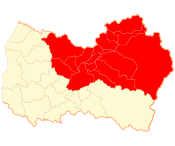Cachapoal Province
| Cachapoal Province Provincia de Cachapoal | |
|---|---|
| Province | |
 | |
 Cachapoal Province | |
| Coordinates: 34°13′S 70°47′W / 34.217°S 70.783°WCoordinates: 34°13′S 70°47′W / 34.217°S 70.783°W | |
| Country | Chile |
| Region | Libertador General Bernardo O'Higgins Region |
| Capital | Rancagua |
| Communes | |
| Government | |
| • Type | Provincial |
| • Governor | Marie Jeane Lyon Amand de Mendieta |
| Area[1] | |
| • Total | 7,384.2 km2 (2,851.1 sq mi) |
| Population (2002 Census)[1] | |
| • Total | 542,901 |
| • Density | 74/km2 (190/sq mi) |
| • Urban | 415,108 |
| • Rural | 127,793 |
| Sex[1] | |
| • Men | 271,226 |
| • Women | 271,675 |
| Time zone | CLT [2] (UTC-4) |
| • Summer (DST) | CLST [3] (UTC-3) |
| Area code(s) | country 56 + area 72 |
| Website | Government of Cachapoal |
Cachapoal Province (Spanish: Provincia de Cachapoal) is one of three provinces of the central Chilean region of O'Higgins (VI). Its capital is the city of Rancagua (pop. 214,344).
Geography and demography
According to the 2002 census by the National Statistics Institute (INE), the province spans an area of 7,384.2 km2 (2,851 sq mi)[1] and had a population of 542,901 inhabitants (271,226 men and 271,675 women), giving it a population density of 73.5 /km2 (190 /sq mi). It is the fifth most populated province in the country. Between the 1992 and 2002 censuses, the population grew by 13.8% (65,871 persons).[1]
Administration
As a province, Cachapoal is a second-level administrative division of Chile, governed by a provincial governor who is appointed by the president.
Communes
The province comprises seventeen communes, each governed by a municipality consisting of an elected alcalde and municipal council.
Cachapoal Valley wine region
Located 85 km (53 mi) south of Santiago, Cachapoal Valley is a wine growing area in the Cachapoal Province in the O`Higgins Region of central Chile, to the north of the Rapel Valley.[4] It is located between the heights of Paine to the north and Pelequén to the south, and between the Andes to the west and the smaller coastal range to the east. The valley takes its name from the Cachapoal river that flows through Rapel Valley along with its tributaries, the Claro and Cortaderal rivers. All these watercourses flow into Lake Rapel.
The climate of the valley is temperate and consistently Mediterranean, sheltered by the coastal range from the cooling influences of the Pacific Ocean.
Most of Cachapoal's noteworthy wineries and vineyards are located towards the east of the region, in the foothills of the Andes, away from the warmer valley floor. This is an area for Cabernet Sauvignon vines, while closer to the coast, where the ocean breezes flow through the coastal range, has more Carmenere vines.


Grape distribution by varietal
- Climate: Mediterranean climate. 340 mm (13.4 in) of rainfall per year.
- Soils: Gravel and sandy soils to the east. Clay to the west.
- Primary wines: Cabernet Sauvignon, Merlot, Syrah, and Carmenere.
| Cabernet Sauvignon: 3,865 ha (9,551 acres) | Merlot: 1,513 ha (3,739 acres) | Carménère: 1,588 ha (3,924 acres) |
| Syrah: 715 ha (1,767 acres) | Sauvignon Blanc: 634 ha (1,567 acres) | Chardonnay: 847 ha (2,093 acres) |
Total hectares planted: 2201 ha (5,439 acres) [5]
References
- ↑ 1.0 1.1 1.2 1.3 1.4 (Spanish) "Territorial division of Chile" (PDF). National Statistics Institute. 2007. Retrieved 18 March 2011.
- ↑ "Chile Time". WorldTimeZones.org. Retrieved 2010-07-28.
- ↑ "Chile Summer Time". WorldTimeZones.org. Retrieved 2010-07-28.
- ↑ Regions, Cachapoal Valley Published by Wine-Searcher.com | Last updated 21-Aug-2013 by Wine-Searcher Staff retrieved October 22, 2013
- ↑ See Cachapoal Valley Chart www.winesofchile.org all right reserved, retrieved September 23, 2013/
External links
- (Spanish) Gobernación de Cachapoal
| |||||||||||||||||
